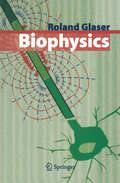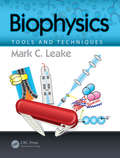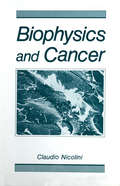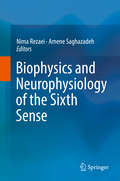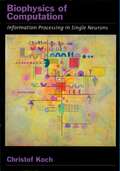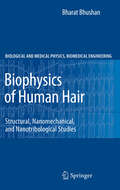- Table View
- List View
Biophysical Effects of Cold Atmospheric Plasma on Glial Tumor Cells (Springer Theses)
by Julia KöritzerCold atmospheric plasma is an auspicious new candidate in cancer treatment. Cold atmospheric plasma (CAP) is a partially ionized gas in which the ion temperature is close to room temperature. It contains electrons, charged particles, radicals, various excited molecules and UV photons. These various compositional elements have the potential to inhibit cancer cell activity whilst doing no harm to healthy cells. Glioblastoma (GBM) is the most common and lethal primary brain tumor in adults; treatment including surgery, radio- and chemotherapy remains palliative for most patients as a cure remains elusive. The successful combination of the standard chemotherapeutic temozolomide (TMZ) and CAP treatment features synergistic effects even in resistant glioma cells. In particular in glioma therapy, CAP could offer an innovative approach allowing specific cancer cell / tumor tissue inhibition without damaging healthy cells. Thus CAP is a promising candidate for combination therapy especially for patients suffering from GBMs showing TMZ resistance.
Biophysical Methods for Biotherapeutics: Discovery and Development Applications
by Tapan K. DasWith a focus on practical applications of biophysical techniques, this book links fundamental biophysics to the process of biopharmaceutical development. • Helps formulation and analytical scientists in pharma and biotech better understand and use biophysical methods • Chapters organized according to the sequential nature of the drug development process • Helps formulation, analytical, and bioanalytical scientists in pharma and biotech better understand and usestrengths and limitations of biophysical methods • Explains how to use biophysical methods, the information obtained, and what needs to be presented in a regulatory filing, assess impact on quality and immunogenicity • With a focus on practical applications of biophysical techniques, this book links fundamental biophysics to the process of biopharmaceutical development.
Biophysical Methods for Biotherapeutics: Discovery and Development Applications
by Tapan K. DasWith a focus on practical applications of biophysical techniques, this book links fundamental biophysics to the process of biopharmaceutical development. • Helps formulation and analytical scientists in pharma and biotech better understand and use biophysical methods • Chapters organized according to the sequential nature of the drug development process • Helps formulation, analytical, and bioanalytical scientists in pharma and biotech better understand and usestrengths and limitations of biophysical methods • Explains how to use biophysical methods, the information obtained, and what needs to be presented in a regulatory filing, assess impact on quality and immunogenicity • With a focus on practical applications of biophysical techniques, this book links fundamental biophysics to the process of biopharmaceutical development.
Biophysical Osteoblast Stimulation for Bone Grafting and Regeneration: From Basic Science to Clinical Applications
by Nahum RosenbergThis book integrates the current basic and clinical knowledge in the area of biophysical stimulation of osteoblast for in vitro and in vivo live bone generation. This innovative methodology and its applications are presented and discussed in several clinical conditions: treatment of fracture nonunion, spine stabilization, bone replacement after tumor resections, stabilization of failed joint endoprostheses in revision surgery and in treatment of bone loss (osteoporosis and osteopenia). The author analyses different types of biophysical stimulation of osteoblasts for bone regeneration, e.g. mechanical (static and alternating, including distraction osteogenesis), electromagnetic (pulsed, alternating, static), light (at different spectrum range, including laser), acoustic (including ultrasound), RF etc. Moreover, he summarizes and discusses the most significant findings for in vitro bone generation and its resulting clinical use as autologous bone graft without surgical morbidity. Reflecting the author’s extensive experience this book is an excellent source of knowledge and a valuable aid to clinical practice for all orthopedic surgeons, fellows, and researchers wanting to gain insights into this promising field.
Biophysical Properties in Glaucoma: Diagnostic Technologies
by Alon Harris Ingrida JanulevicieneThis book provides an overview on new insights in glaucoma, the latest technological developments, scientific achievements, and novel research leading to new paradigms in glaucoma diagnosis. Readers will discover a broad picture starting from theoretical perspectives in diagnostic criteria followed by practical examination and clinical interpretations while highlighting potential pitfalls and limitations in analysis. Non-invasive, modern technologies allowing visualization and quantification of various parts of the human eye are fast evolving and improving interpretation of modern diagnostic possibilities are essential to fill the gap between sophisticated equipment, complex clinical data, and the need for precision-medicine based interpretation. Issues such as the importance of intraocular, intracranial, and ocular perfusion pressures (IOP, ICP, OPP) in the pathogenesis of glaucoma; and imaging modalities for examination of the optic nerve head, retinal fiber layer, and visual field assessment in glaucoma are explored in these chapters. The problem-based learning approach presented herein offers a succinct go-to-guide to read and discover answers.
Biophysical Regulation of Vascular Differentiation and Assembly (Biological and Medical Physics, Biomedical Engineering)
by Sharon GerechtBecause of their ability to differentiate and develop into functional vasculature, stem cells hold tremendous promise for therapeutic applications. However, the scientific understanding and the ability to engineer these cellular systems is still in its early stages, and must advance significantly for the therapeutic potential of stem cells to be realized. Stem cell differentiation and function are exquisitely tuned by their microenvironment. This book will provide a unique perspective of how different aspect of the vasculature microenvironment regulates differentiation and assembly. Recent efforts to exploits modern engineering techniques to study and manipulate various biophysical cues will be described including: oxygen tension during adult and embryonic vasculogenesis (Semenza and Zandstra), extracellular matrix during tube morphogenesis and angiogenesis (Wirtz, Davis, Ingber), surface topography and modification (Chen and Gerecht), shear stress and cyclic strain effect on vascular assembly and maturation (Vunjak-Novakovic and Niklason), and three dimensional space for angio-andvasculogensis (Ferreria and Fischbach).
Biophysics
by Roland GlaserBiophysics is the science of physical principles underlying the "phenomenon of life" on all levels of organization. This book begins by explaining molecular and ionic interactions, movements, excitation and energy transfer, and the self-organization of supramolecular structures. Then the biological organism is introduced as a non-equilibrium system. Finally, system analyses are discussed as well as environmental biophysics, ecological interactions, growth, differentiation, and evolution. A growing number of applications in biotechnology are based on these biophysical concepts.
Biophysics: An Introduction
by Roland GlaserBiophysics is the science of physical principles underlying all processes of life, including the dynamics and kinetics of biological systems.This fully revised 2nd English edition is an introductory text that spans all steps of biological organization, from the molecular, to the organism level, as well as influences of environmental factors. In response to the enormous progress recently made, especially in theoretical and molecular biophysics, the author has updated the text, integrating new results and developments concerning protein folding and dynamics, molecular aspects of membrane assembly and transport, noise-enhanced processes, and photo-biophysics. The advances made in theoretical biology in the last decade call for a fully new conception of the corresponding sections. Thus, the book provides the background needed for fundamental training in biophysics and, in addition, offers a great deal of advanced biophysical knowledge.
Biophysics
by W. Hoppe W. Lohmann H. Markl H. ZieglerWhat is biophysics? As with all subjects which straddle traditional boundaries between fields, it eludes a precise definition. Furthermore, it is impossible to do biophysics without having a certain foundation of knowledge in biology, physics, physical chemistry, chemistry and biochemistry. One approach to a biophysics textbook would be to refer the student to the literature of these neighboring fields, and to leave the selection of the appropriate supplementary material up to the student. The editors of this volume are of the opinion that it is more useful and less time-consuming to present a selection of the supplementary knowledge, in concentrated form, together with the subject matter specific to biophysics. The reader will thus find in this book introductions to such subjects as the structure and function of the cell, the chemical structure of biogenic macromolecules, and even theoretical chemistry. What, indeed, is biophysics? Must we consider it to include physiology, electromedicine, radiation medicine, etc. ? The field has evolved continuously in recent years. Molecular understanding oflife processes has come more and more to the fore. Just as the field of molecular physics has developed to describe structures and processes in the realm of non-living systems, there has been a corresponding development of molecular biophysics.
Biophysics: Tools and Techniques
by Mark C. LeakeAn Up-to-Date Toolbox for Probing Biology Biophysics: Tools and Techniques covers the experimental and theoretical tools and techniques of biophysics. It addresses the purpose, science, and application of all physical science instrumentation and analysis methods used in current research labs. The book first presents the historical background, concepts, and motivation for using a physical science toolbox to understand biology. It then familiarizes undergraduate students from the physical sciences with essential biological knowledge. The text subsequently focuses on experimental biophysical techniques that primarily detect biological components or measure/control biological forces. The author describes the science and application of key tools used in imaging, detection, general quantitation, and biomolecular interaction studies, which span multiple length and time scales of biological processes both in the test tube and in the living organism. Moving on to theoretical biophysics tools, the book presents computational and analytical mathematical methods for tackling challenging biological questions including exam-style questions at the end of each chapter as well as step-by-step solved exercises. It concludes with a discussion of the future of this exciting field. Future innovators will need to be trained in multidisciplinary science to be successful in industry, academia, and government support agencies. Addressing this challenge, this textbook educates future leaders on the development and application of novel physical science approaches to solve complex problems linked to biological questions. Features: Provides the full, modern physical science toolbox of experimental and analytical techniques, such as bulk ensemble methods, single-molecule tools, and live-cell and test tube methods Incorporates worked examples for the most popular physical science tools, including full diagrams and a summary of the science involved in the application of the tool Reinforces the understanding of key concepts and biological questions A solutions manual is available upon qualifying course adoption.
Biophysics: Tools and Techniques
by Mark C. LeakeAn Up-to-Date Toolbox for Probing Biology Biophysics: Tools and Techniques covers the experimental and theoretical tools and techniques of biophysics. It addresses the purpose, science, and application of all physical science instrumentation and analysis methods used in current research labs. The book first presents the historical background, concepts, and motivation for using a physical science toolbox to understand biology. It then familiarizes undergraduate students from the physical sciences with essential biological knowledge. The text subsequently focuses on experimental biophysical techniques that primarily detect biological components or measure/control biological forces. The author describes the science and application of key tools used in imaging, detection, general quantitation, and biomolecular interaction studies, which span multiple length and time scales of biological processes both in the test tube and in the living organism. Moving on to theoretical biophysics tools, the book presents computational and analytical mathematical methods for tackling challenging biological questions including exam-style questions at the end of each chapter as well as step-by-step solved exercises. It concludes with a discussion of the future of this exciting field. Future innovators will need to be trained in multidisciplinary science to be successful in industry, academia, and government support agencies. Addressing this challenge, this textbook educates future leaders on the development and application of novel physical science approaches to solve complex problems linked to biological questions. Features: Provides the full, modern physical science toolbox of experimental and analytical techniques, such as bulk ensemble methods, single-molecule tools, and live-cell and test tube methods Incorporates worked examples for the most popular physical science tools, including full diagrams and a summary of the science involved in the application of the tool Reinforces the understanding of key concepts and biological questions A solutions manual is available upon qualifying course adoption.
Biophysics: Tools and Techniques for the Physics of Life
by Mark C. LeakeBiophysics: Tools and Techniques for the Physics of Life covers the experimental, theoretical, and computational tools and techniques of biophysics. It addresses the purpose, science, and application of all physical science instrumentation, theoretical analysis, and biophysical computational methods used in current research labs. The book first presents the historical background, concepts, and motivation for using a physical science toolbox to understand biology. It then familiarizes undergraduate students from the physical sciences with essential biological knowledge. The text subsequently focuses on experimental biophysical techniques that primarily detect biological components or measure/control biological forces. The author describes the science and application of key tools used in imaging, detection, general quantitation, and biomolecular interaction studies, which span multiple length and time scales of biological processes both in the test tube and in the living organism. Moving on to theoretical and computational biophysics tools, the book presents analytical mathematical methods and numerical simulation approaches for tackling challenging biological questions including exam-style questions at the end of each chapter as well as step-by-step solved exercises. It concludes with a discussion of the future of this exciting field. Future innovators will need to be trained in multidisciplinary science to be successful in industry, academia, and government support agencies. Addressing this challenge, this textbook educates future leaders on the development and application of novel physical science approaches to solve complex problems linked to biological questions. Features: Provides the full, modern physical science toolbox of experimental, theoretical, and computational techniques, such as bulk ensemble methods, single-molecule tools, live-cell and test tube methods, pencil-on-paper theory approaches, and simulations. Incorporates worked examples for the most popular physical science tools by providing full diagrams and a summary of the science involved in the application of the tool. Reinforces the understanding of key concepts and biological questions. A solutions manual is available upon qualifying course adoption.
Biophysics: Tools and Techniques for the Physics of Life
by Mark C. LeakeBiophysics: Tools and Techniques for the Physics of Life covers the experimental, theoretical, and computational tools and techniques of biophysics. It addresses the purpose, science, and application of all physical science instrumentation, theoretical analysis, and biophysical computational methods used in current research labs. The book first presents the historical background, concepts, and motivation for using a physical science toolbox to understand biology. It then familiarizes undergraduate students from the physical sciences with essential biological knowledge. The text subsequently focuses on experimental biophysical techniques that primarily detect biological components or measure/control biological forces. The author describes the science and application of key tools used in imaging, detection, general quantitation, and biomolecular interaction studies, which span multiple length and time scales of biological processes both in the test tube and in the living organism. Moving on to theoretical and computational biophysics tools, the book presents analytical mathematical methods and numerical simulation approaches for tackling challenging biological questions including exam-style questions at the end of each chapter as well as step-by-step solved exercises. It concludes with a discussion of the future of this exciting field. Future innovators will need to be trained in multidisciplinary science to be successful in industry, academia, and government support agencies. Addressing this challenge, this textbook educates future leaders on the development and application of novel physical science approaches to solve complex problems linked to biological questions. Features: Provides the full, modern physical science toolbox of experimental, theoretical, and computational techniques, such as bulk ensemble methods, single-molecule tools, live-cell and test tube methods, pencil-on-paper theory approaches, and simulations. Incorporates worked examples for the most popular physical science tools by providing full diagrams and a summary of the science involved in the application of the tool. Reinforces the understanding of key concepts and biological questions. A solutions manual is available upon qualifying course adoption.
Biophysics: A Student’s Guide to the Physics of the Life Sciences and Medicine
by William C. ParkeThis comprehensive and extensively classroom-tested biophysics textbook is a complete introduction to the physical principles underlying biological processes and their applications to the life sciences and medicine. The foundations of natural processes are placed on a firm footing before showing how their consequences can be explored in a wide range of biosystems. The goal is to develop the readers’ intuition, understanding, and facility for creative analysis that are frequently required to grapple with problems involving complex living organisms. Topics cover all scales, encompassing the application of statics, fluid dynamics, acoustics, electromagnetism, light, radiation physics, thermodynamics, statistical physics, quantum biophysics, and theories of information, ordering, and evolutionary optimization to biological processes and bio-relevant technological implementations. Sound modeling principles are emphasized throughout, placing all the concepts within a rigorous framework. With numerous worked examples and exercises to test and enhance the reader’s understanding, this book can be used as a textbook for physics graduate students and as a supplementary text for a range of premedical, biomedical, and biophysics courses at the undergraduate and graduate levels. It will also be a useful reference for biologists, physicists, medical researchers, and medical device engineers who want to work from first principles.
Biophysics
by V. Pattabhi N. GauthamBiophysics, being an interdisciplinary topic, is of great importance in modern biology. This book addresses the needs of biologists, biochemists, and medical biophysicists for an introduction to the subject. The text is based on a one-semester course offered to graduate students of life sciences, and covers a wide range of topics from quantum mechanics to pre-biotic evolution. To understand the topics, only basic school level mathematics is required. The first chapter introduces and refreshes the reader's knowledge of physics and chemistry. The next chapters cover various physico-chemical techniques used to study biomolecular structures, followed by treatments of spectroscopy, microscopy, diffraction, and computational techniques. X-ray crystallography and NMR are dealt with in greater detail. The latter half of the book covers results obtained from applications of the above techniques. Some of the other topics dealt with are energy pathways, biomechanics, and neuro-biophysics.
Biophysics and Cancer
by Claudio NicoliniSince the early times of the Greek philosophers Leucippus and Democritus, and later of the Roman philosopher Lucretius, a simple, fundamental idea emerged that brought the life sciences into the realm of the physical sciences. Atoms, after various interactions, were assumed to acquire stable configurations that corresponded either to the living or to the inanimate world. This simple and unitary theory, which has evolved in successive steps to our present time, remarkably maintained its validity despite several centuries of alternative vicissitudes, and is the foundation of modern biophysics. Some of the recent developments of this ancient idea are the discovery of the direct relationship between spatial structures and chemical activity of such molecules as methane and benzene, and the later discovery of the three-dimensional structure of double-helical DNA, and of its relationship with biological activity. The relationship between the structure of various macromolecules and the function of living cells was one of the most striking advancements of modern science, obtained by the cooperation of physicists, chemists, mathematicians, engineers, biologists, and physicians. This crossing of the life and physical sciences has given rise to new and exciting frontiers, and to a new synthesis where there is a frequent interconnection of expertise, and where there is an exchange of roles among traditionally separated soft and hard sciences. Even if knowledge is still transmitted to new generations within univer sities as separate disciplines, new knowledge is acquired today in the laboratory by truly interdisciplinary teams.
Biophysics and Neurophysiology of the Sixth Sense
by Nima Rezaei Amene SaghazadehMultiple senses, like multiple intelligences, are a key to brain variability and therefore human evolution. Besides the traditional five senses (vision, olfaction, gustation, audition, and somatosensory), humans can also perceive the body’s own position (the sense of proprioception) and movement (the vestibular sense). Interoception is the feeling one has about the internal physiological conditions of the entire body. Additionally there is a sense of intuition, also known as the sixth sense. Despite their best efforts, researchers are still unable to concur in specifying the nature of the sixth sense; some consider the sense of proprioception as the sixth sense, whereas others prefer to consider that as a part of interoception. This book will provide a scientific system for the human sixth sense using relevant biophysical and neurophysiological evidence. The power of “sixth sense” seems to be underestimated, due to difficulties in defining the concept clearly. According to socioeconomics and neural physics, the sixth sense is that which permits humans to create perception or to enhance the quality of their perception of events. Roughly speaking, the sixth sense engages a metacognitive process through which prior knowledge and the information received from other sensory modalities are synergized. It is not restricted to specific arrow of time and type of mind or to the observer’s body, but it considers all arrows of time (past, present, future), types of mind (conscious and unconscious), and physical bodies (self and other). However it is expected that the observer has specific biases towards what happens now or would happen in the future and its relation to himself. Particularly, humans appeal to the sixth sense on the road to achieving success in social competitions and to reduce uncertainty in complex decision making processes. In addition to evidence linking genetic components to the sixth sense submodalities, there have been developed strategies for increasing the quality of perceptions provided by the sixth sense. Meditation, through which individuals try to be detached from the world, increases gamma-band activity and that increased gamma-band activity is found following top-down processing. Therefore it can be inferred that the detachment from the environment may enhance synchronization of the wave functions in favor of strengthening the sixth sense. It can serve as the mechanism of enhancement of the sixth sense in those whose sensory systems are intact, it can also serve as the mechanism of compensation in those who have sensory deficiencies. In the latter case, it in fact encourages creativity in the use of relatively strong senses. This justifies Beethoven's deafness and his great musical creativity or Bramblitt's blindness and his enormous capability to paint and many other similar examples.In summary, the present book is divided into five parts. Part 1 (chapters 1-6) provides information about the system of proprioception and its neurophysiology and biophysics. Part 2 (chapters 7-10) examines the system of interoception. The information provided in these two parts would enable us to move towards the next three parts of the story, aimed at developing a scientific system of the sixth sense. The first chapter of part 3 begins with concepts and uses them to arrive at reasonable conclusion that there must be a sense that requires multistep information processing and that is separate from the sense of proprioception and the sense of interoception. Such sense is commonly known as the sixth sense. However it should be re-numbered because the sense of proprioception is already known as the sixth sense. The second chapter of this part is to draw neurocircuitry that innervates the sixth sense in the mind of a man, while the third chapter would address the questions whether the sixth sense system requires an optimal competence or consciousness of mind to function properly and if so which is the optimal state: conscious or unconscious and competence or incompetence. In the fourth chapter of this part, we will focus on t
Biophysics for Therapeutic Protein Development (Biophysics for the Life Sciences #4)
by Linda O. NarhiThis book can be used to provide insight into this important application of biophysics for those who are planning a career in protein therapeutic development, and for those outside this area who are interested in understanding it better. The initial chapters describe the underlying theory, and strengths and weaknesses of the different techniques commonly used during therapeutic development. The majority of the chapters discuss the applications of these techniques, including case studies, across the product lifecycle from early discovery, where the focus is on identifying targets, and screening for potential drug product candidates, through expression and purification, large scale production, formulation development, lot-to-lot comparability studies, and commercial support including investigations.
The Biophysics of Cell Membranes: Biological Consequences (Springer Series in Biophysics #19)
by Richard M. Epand Jean-Marie RuysschaertThis volume focuses on the modulation of biological membranes by specific biophysical properties. The readers are introduced to emerging biophysical approaches that mimick specific states (like membrane lipid asymmetry, membrane curvature, lipid flip-flop, lipid phase separation) that are relevant to the functioning of biological membranes. The first chapter describes innovative methods to mimic the prevailing asymmetry in biological membranes by forming asymmetrical membranes made of monolayers with different compositions. One of the chapters illustrates how physical parameters, like curvature and elasticity, can affect and modulate the interactions between lipids and proteins. This volume also describes the sensitivity of certain ion channels to mechanical forces and it presents an analysis of how cell shape is determined by both the cytoskeleton and the lipid domains in the membrane. The last chapter provides evidence that liposomes can be used as a minimal cellular model to reconstitute processes related to the origin of life. Each topic covered in this volume is presented by leading experts in the field who are able to present clear, authoritative and up-to-date reviews. The novelty of the methods proposed and their potential for a deeper molecular description of membrane functioning are particularly relevant experts in the areas of biochemistry, biophysics and cell biology, while also presenting clear and thorough introductions, making the material suitable for students in these fields as well.
Biophysics of Computation: Information Processing in Single Neurons (Computational Neuroscience Series)
by Christof KochNeural network research often builds on the fiction that neurons are simple linear threshold units, completely neglecting the highly dynamic and complex nature of synapses, dendrites, and voltage-dependent ionic currents. Biophysics of Computation: Information Processing in Single Neurons challenges this notion, using richly detailed experimental and theoretical findings from cellular biophysics to explain the repertoire of computational functions available to single neurons. The author shows how individual nerve cells can multiply, integrate, or delay synaptic inputs and how information can be encoded in the voltage across the membrane, in the intracellular calcium concentration, or in the timing of individual spikes. Key topics covered include the linear cable equation; cable theory as applied to passive dendritic trees and dendritic spines; chemical and electrical synapses and how to treat them from a computational point of view; nonlinear interactions of synaptic input in passive and active dendritic trees; the Hodgkin-Huxley model of action potential generation and propagation; phase space analysis; linking stochastic ionic channels to membrane-dependent currents; calcium and potassium currents and their role in information processing; the role of diffusion, buffering and binding of calcium, and other messenger systems in information processing and storage; short- and long-term models of synaptic plasticity; simplified models of single cells; stochastic aspects of neuronal firing; the nature of the neuronal code; and unconventional models of sub-cellular computation. Biophysics of Computation: Information Processing in Single Neurons serves as an ideal text for advanced undergraduate and graduate courses in cellular biophysics, computational neuroscience, and neural networks, and will appeal to students and professionals in neuroscience, electrical and computer engineering, and physics.
Biophysics of Computation: Information Processing in Single Neurons (Computational Neuroscience Series)
by Christof KochNeural network research often builds on the fiction that neurons are simple linear threshold units, completely neglecting the highly dynamic and complex nature of synapses, dendrites, and voltage-dependent ionic currents. Biophysics of Computation: Information Processing in Single Neurons challenges this notion, using richly detailed experimental and theoretical findings from cellular biophysics to explain the repertoire of computational functions available to single neurons. The author shows how individual nerve cells can multiply, integrate, or delay synaptic inputs and how information can be encoded in the voltage across the membrane, in the intracellular calcium concentration, or in the timing of individual spikes. Key topics covered include the linear cable equation; cable theory as applied to passive dendritic trees and dendritic spines; chemical and electrical synapses and how to treat them from a computational point of view; nonlinear interactions of synaptic input in passive and active dendritic trees; the Hodgkin-Huxley model of action potential generation and propagation; phase space analysis; linking stochastic ionic channels to membrane-dependent currents; calcium and potassium currents and their role in information processing; the role of diffusion, buffering and binding of calcium, and other messenger systems in information processing and storage; short- and long-term models of synaptic plasticity; simplified models of single cells; stochastic aspects of neuronal firing; the nature of the neuronal code; and unconventional models of sub-cellular computation. Biophysics of Computation: Information Processing in Single Neurons serves as an ideal text for advanced undergraduate and graduate courses in cellular biophysics, computational neuroscience, and neural networks, and will appeal to students and professionals in neuroscience, electrical and computer engineering, and physics.
Biophysics of DNA-Protein Interactions: From Single Molecules to Biological Systems (Biological and Medical Physics, Biomedical Engineering)
by Mark C. Williams and L. James MaherDepite the rapid expansion of the field of biophysics, there are very few books that comprehensively treat specific topics in this area. Recently, the field of single molecule biophysics has developed very quickly, and a few books specifically treating single molecule methods are beginning to appear. However, the promise of single molecule biophysics is to contribute to the understanding of specific fields of biology using new methods. This book would focus on the specific topic of the biophysics of DNA-protein interactions, and would include the use of new approaches, including both bulk methods as well as single molecule methods. This would make the book attractive to anyone working in the general area of DNA-protein interactions, which is of course a much wider market than just single molecule biophysicists or even biophysicists. The subject of the book will be the biophysics of DNA-protein interactions, and will include new methods and results that describe the physical mechanism by which proteins interact with DNA. For example, there has been much recent work on the mechanism by which proteins search for specific binding sites on DNA. A few chapters will be devoted to experiments and theory that shed light on this important problem. We will also cover proteins that alter DNA properties to facilitate interactions important for transcription or replication. Another section of the book will cover the biophysical mechanism by which motor proteins interact with DNA. Finally, we will cover larger protein-DNA complexes, such as replication forks, recombination complexes, DNA repair interactions, and their chromatin context.
Biophysics of Human Hair: Structural, Nanomechanical, and Nanotribological Studies (Biological and Medical Physics, Biomedical Engineering)
by Bharat BhushanBiophysics of Infection (Advances in Experimental Medicine and Biology #915)
by Mark C. LeakeThis book describes modern biophysical techniques that enable us to understand and examine dynamic processes of infection at the molecular level. Cutting-edge research articles, laboratory protocols, case studies and up-to-date reviews cover topics such as single-molecule observation of DNA replication repair pathways in E. coli; evolution of drug resistance in bacteria; restriction enzymes as barriers to horizontal gene transfer in Staphylococcus aureus; infectious and bacterial pathogen biofilms; killing infectious pathogens through DNA damage; bacterial surfaces in host-pathogen interactions; bacterial gene regulation by riboswitches; transcription regulation in enterobacterial pathogens; the bacterial flagellar motor; initial surface colonization by bacteria; Salmonella Typhi host restrictions; as well as monitoring proton motive force in bacteria; microbial pathogens using digital holography; mathematical modelling of microbial pathogen motility; neutron reflectivity in studying bacterial membranes; force spectroscopy in studying infection and 4D multi-photon imaging to investigate immune responses. The focus is on the development and application of complex techniques and protocols at the interface of life sciences and physics, which increase the physiological relevance of biophysical investigations.
Biophysics of Mitochondria
by Nikolai VekshinIn this monograph, the author -Head researcher at the Institute of Cell Biophysics of Russian Academy of Sciences- discusses the results of his own long-term studies of mitochondria as well as alternative points of view and experiments of other important researchers in the field. The monograph contains the main aspects of mitochondrial research by a number of physical methods: fluorescence spectroscopy, UV-vis spectrophotometry, IR spectroscopy, light-scattering, optical microscopy, fluorescence microscopy, colorimetry, photobleaching, polarography, among others. The monograph is very useful for researchers and graduate students specializing in mitochondrial biophysics, biochemistry, molecular biology and cytology. The book was published in Russian in 2019 by Photon Publishers (Pushchino, Moscow region).





